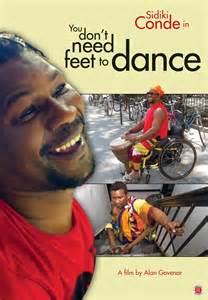Sidiki Conde is a polio survivor. He is also an inspiration.
Conde, who’s been paralyzed since the time he turned 14, transformed his lifelong tragedy into triumph, teaching two hands to do the work of every other limb. Over the years, Conde has taught himself how to cook meals and dance; compete and busk. He educates young children. He jams with bands in Union Square. All of which might explain why Conde’s story seems so fascinating. The only problem being You Don’t Need Feet to Dance completely fails to do it justice.
Consider this: By the time You Don’t Need Feet to Dance has reached the 45-minute mark, Director Alan Govenar has already forced his audience to amble through Conde waking up, rolling out of bed, crawling to the bathroom, propping himself up, brushing his own teeth, taking a quick bath, feeding his cats, feeding himself, getting dressed, ordering a sandwich, praying at a Mosque, eating lunch, teaching children, beating drums, riding a bike, riding a subway, riding an elevator, buying a phone card, climbing up five flights, easing down five more, climbing up five more, easing down five more … every single frame of it set to no production value whatsoever.
The point being, as a filmmaker, you need to understand the middling difference between low-budget and low-rent. In this case, it was incumbent upon Govenar to portray Sidiki as the modern-day hero he so very is. Unfortunately, the former got so wholly wound up in minutia, he completely lost his sense of what the bigger – if not infinitely more effective – documentary might be.
(You Don’t Need Feet to Dance opens for a limited engagement at the Quad Cinema in New York City this coming Friday, March 22.)

